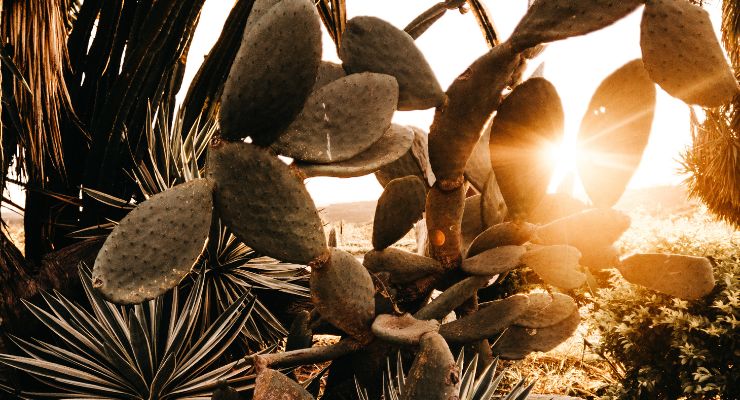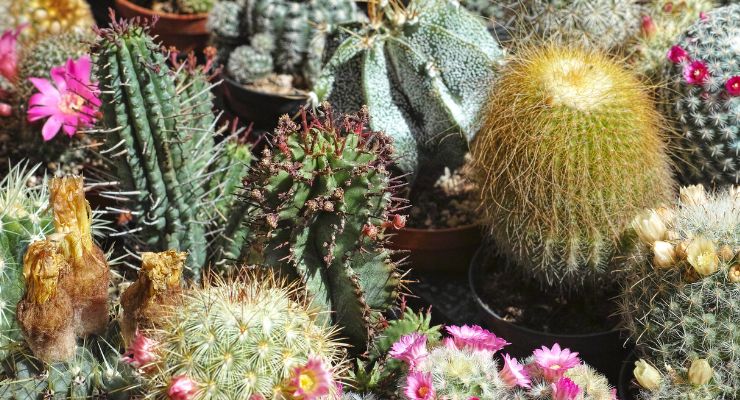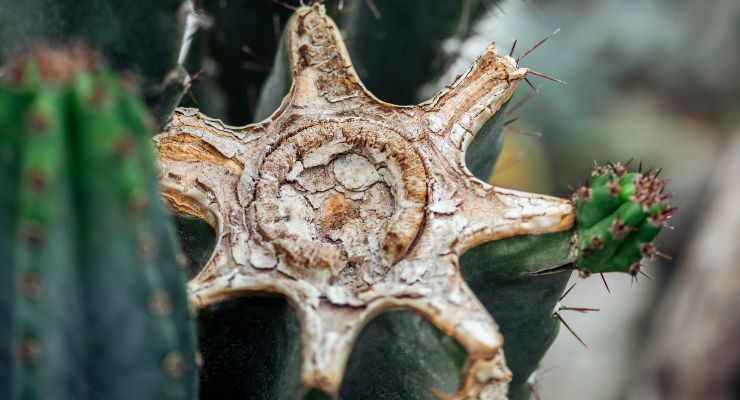Sunburn of cactus occurs when a cactus plant is exposed to excessive sunlight for a prolonged period. Excessive exposure to sunlight can cause the plant to become scorched, discolored, and damaged, particularly on the parts of the plant that are exposed to direct sunlight.
Cacti are adapted to survive in hot, dry desert conditions, but they can still suffer from sunburn if they are exposed to too much sun. Sunburn can also occur when a cactus is moved from a shaded area to a location with the direct sun without giving the plant time to adjust.
The symptoms of sunburn in cacti can include discoloration, browning, and even blackening of the skin or tissues of the plant. In severe cases, the plant may wilt or even die. To prevent sunburn in cacti, it is essential to provide them with adequate shade, particularly during the hottest parts of the day.
Causes of Sunburn Cactus
There are some options that might cause sunburn on cacti. Let’s see them one by one:
Exposure to Direct Sunlight
Explanation of Photosynthesis and its Importance
Photosynthesis is the process by which plants use sunlight, carbon dioxide, and water to produce glucose (sugar) and oxygen. This process is essential for the survival of plants, as it provides them with the energy they need to grow and reproduce.
In photosynthesis, chlorophyll (a green pigment found in the chloroplasts of plant cells) captures sunlight and converts it into chemical energy. The energy is then used to power the synthesis of glucose from carbon dioxide and water. Oxygen is released as a byproduct of this process.
Explanation of Sunburn and its Effects
Sunburn occurs when a cactus is exposed to full sun for an extended period, causing damage to its tissues. When a cactus is exposed to too much sunlight, the intense heat and UV radiation can damage its chlorophyll and other pigments, leading to the breakdown of the plant’s cellular structure.
The effects of sunburn on cacti can range from mild discoloration and browning to severe tissue damage and death. In severe cases, the cactus may develop dark, sunken lesions, or the affected tissue may turn black and become necrotic. The plant may also become dehydrated, wilt, and eventually die.
It is essential to note that not all cacti are equally susceptible to sunburn. Some species have evolved to withstand high levels of sunlight and heat, while others may be more sensitive and require more shade. Factors such as the age of the plant, its overall health, and environmental conditions can also affect its susceptibility to sunburn.

High Temperature and Low Humidity
Effects of High Temperature and Low Humidity on Cactus
Cacti are adapted to hot, arid conditions and can survive in high temperatures and low humidity levels. However, prolonged light exposure to high temperatures and low humidity can still have negative effects on cacti.
When the temperature is high and the humidity is low, cacti can lose water more quickly through transpiration, which is the process of water loss through the leaves and stems of the plant. This can lead to dehydration and wilting, and in extreme cases, the cactus may even die.
Explanation of Heat Stress and its Effects
Heat stress occurs when a plant is suddenly exposed to high temperatures that exceed its physiological limits. When a cactus experiences heat stress, its metabolism can slow down, and it may be unable to absorb nutrients properly. This can lead to stunted growth and reduced plant vigor.
In addition, high temperatures can also cause cellular damage, especially in the chloroplasts, which are responsible for photosynthesis. The damage can lead to reduced photosynthetic efficiency, reduced nutrient production, and eventually, a decline in overall plant health.
Heat stress can also make cacti more susceptible to other stresses, such as drought and disease, and can increase the risk of sunburn. To prevent heat stress in cacti, it is essential to provide them with adequate shade and to water them regularly, especially during periods of hot, dry weather.
Can a Cactus Get Too Much Sun?
Yes, a cactus can get too much sun. Excess sunlight refers to prolonged exposure to intense sunlight that exceeds the plant’s physiological limits. While cacti are adapted to survive in hot, arid environments, they still require protection from excessive sunlight to prevent damage to their tissues.
The effects of excess sunlight on cacti can range from mild discoloration and browning to severe tissue damage and death. Excessive exposure of a cactus to sunlight can cause damage to its chlorophyll and other pigments, resulting in the disruption of the plant’s cellular structure due to the intense heat and UV radiation.
In addition, excess sunlight can also cause dehydration and wilting, as the plant loses water more quickly through transpiration. This can lead to a decline in overall plant health and reduced growth and productivity.

How Do You Know Your Cactus Is Getting Sunburned?
Sunburn is a common problem that can affect many cacti species, especially those grown in hot, sunny environments. Signs of sunburn in cacti may include:
Brown or black patches on the skin or tissues of the plant
Sunken lesions on the plant
Discoloration or bleaching of the plant’s tissues
Reduced growth or productivity
Increased susceptibility to pests and diseases
Differentiating Between Sunburn and Other Plant Diseases
Sunburn can sometimes be mistaken for other plant diseases, such as fungal infections or bacterial wilt. To differentiate between sunburn and other plant diseases, it is essential to examine the affected areas closely and look for signs of sun exposure.
If the plant has been exposed to full sun for prolonged periods, and the affected areas show signs of blistering, cracking, or sunken lesions, it is likely that the plant has sunburn. On the other hand, if the affected areas show signs of fungal growth or other abnormal growth patterns, it may indicate the presence of a fungal or bacterial disease.
It is important to take appropriate measures to treat the underlying cause of the problem to prevent further damage to the plant.
Caring for Sunburned Cacti
Sunburn can cause significant damage to cacti, but with proper care and attention, the plant can recover and return to good health. Here are some steps you can take to care for sunburned cacti:
Assessing the Damage
The first step in caring for sunburned cacti is to assess the extent of the damage. Determine the severity of the sunburn and the extent to which the plant’s tissues have been affected. This will help you determine the appropriate course of action to take.
Trimming Affected Parts
If the sunburn has caused significant damage to the cactus, you may need to trim away the affected parts. Use a sharp, clean pair of scissors or pruning shears to carefully remove any damaged or dead tissue. Be sure to sanitize your tools before and after use to prevent the spread of disease.

Repotting in Fresh Soil
After trimming away any damaged tissue, consider repotting your cactus in fresh soil. This will help provide the plant with the nutrients it needs to recover and grow. Choose a well-draining soil mix that is suitable for cacti, and be sure to place the plant in a pot with good drainage holes.
Application of Fertilizer
To encourage growth and recovery, you can apply a slow-release fertilizer specifically formulated for cacti. Follow the manufacturer’s instructions for application rates and frequency, and be sure not to over-fertilize, as this can lead to further damage.
Adjusting Watering Schedule
Adjusting the watering schedule is essential in caring for a sunburned cactus. After the plant has been repotted, water it sparingly, allowing the soil to dry out between watering. This will help prevent further damage and dehydration. Be sure to monitor the plant closely and adjust the watering schedule as needed based on its response.
Overall, caring for a sunburned cactus requires patience and attention to detail. With proper care and attention, the plant can recover and return to good health.
Preventing Sunburn in Cacti
Prevention is key when it comes to protecting cacti from sunburn. Here are some steps you can take to prevent sunburn in your cacti:
One of the easiest ways to protect cacti from sunburn is to use shade cloth or netting. This can help reduce the intensity of the sunlight and prevent direct exposure to harmful UV rays. Cloth or netting can be purchased from most garden centers or online retailers and can be easily attached to a support structure above the cacti.
Cacti are adapted to arid environments and do not require frequent watering. However, during periods of high temperatures or prolonged exposure to direct sunlight, they may need more water to prevent dehydration. Adjusting the watering schedule can help prevent sunburn by ensuring that the cacti are adequately hydrated and able to regulate their internal temperature.
Applying sunscreen or a UV filter to the cacti’s skin can help protect it from harmful UV rays. This can be done by spraying a light layer of sunscreen or UV filter on the cacti’s skin, being careful not to apply too much and suffocate the plant.
Choosing the right location for your cacti is also important in preventing sunburn. Avoid placing them in areas that receive prolonged exposure to direct sunlight, such as on windowsills or in south-facing areas. Instead, choose a location that provides some shade during the hottest part of the day, such as under a shaded tree or area of your garden.
In conclusion, sunburn can be a serious problem for cacti, but it can be prevented with proper care and attention. By using netting, adjusting the watering schedule, applying sunscreen or a UV filter, and choosing the right location, you can help protect your cacti from sunburn and ensure that they remain healthy and vibrant for years to come.

Can I Save a Sunburned Cactus Plant?
Whether or not you can save a sunburned cactus plant depends on the severity of the damage. Mild cases of a sunburned appearance can be treated with proper care and attention, while severe cases may require the help of a professional or may not be salvageable at all.
If your cactus has suffered from sunburn, here are some tips on how to save it:
Move the plant to a shaded area to prevent further damage from sunlight.
Assess the damage and remove any severely affected or dead parts of the cactus with a sterilized pair of pruning shears.
Repot the cactus in fresh soil to help it recover.
Adjust the watering schedule to ensure the cactus receives enough water to help it recover.
Apply a light layer of fertilizer to help stimulate growth.
When to Seek Professional Help?
If the sunburn damage is severe and affects a large portion of the cactus or if the cactus is showing signs of other problems, such as fungal or bacterial infections, it may be best to seek the help of a professional.
A professional can assess the sun damage and recommend appropriate treatment, such as fungicides or antibiotics, to help save the plant.
If you are unsure about how to care for a sunburned cactus, seeking professional help can be beneficial to ensure the best chances of recovery for your plant.
Summary
Sunburn is a common problem for cactus plants that are exposed to too much direct sunlight for extended periods. The intense heat and UV rays can damage the cactus’s skin, causing it to turn brown, black, or bright yellow, and even die if left untreated.
Preventing sunburn in cacti is crucial to ensure their long-term health and vitality. Measures such as using shade cloth, adjusting watering schedules, applying sunscreen or UV filters, and choosing the right location can all help prevent sunburn.
In the event of sunburn, proper treatment and care, including assessing the damage, trimming affected parts, repotting in fresh soil, adjusting watering schedules, and applying fertilizer, can help save the plant.
In conclusion, cacti are unique and fascinating plants that require proper care to thrive. Prevention is key to avoiding sunburn and other problems in cacti.
If your cactus plant has suffered from sunburn, there are steps you can take to help it recover, but it is also essential to seek professional help if the damage is severe. By following these tips and recommendations, you can enjoy the beauty and benefits of healthy cactus plants in your home or garden.

